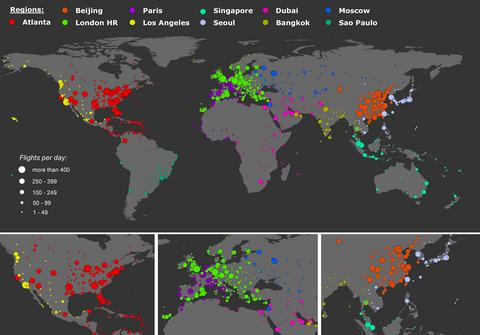Our official English website, www.x-mol.net, welcomes your feedback! (Note: you will need to create a separate account there.)
Global spatial organisation of air transport: The definition of functional airline regions
The Geographical Journal ( IF 3.384 ) Pub Date : 2019-07-18 , DOI: 10.1111/geoj.12313 Marián Halás 1 , Stanislav Kraft 2 , Pavel Klapka 1
The Geographical Journal ( IF 3.384 ) Pub Date : 2019-07-18 , DOI: 10.1111/geoj.12313 Marián Halás 1 , Stanislav Kraft 2 , Pavel Klapka 1
Affiliation

|
This paper deals with the issue of functional regionalisation on the global level and uses information on air transport movements as the regionalisation criterion. The analysis is based on analogies regarding the use of traditional methods, scale, and character of input information (flows) by which functional regions are usually defined. The paper tries to verify whether these analogies are viable and whether the approach can be used to assess the spatial organisation of air transport on the global level. In order to do so, the paper discusses some aspects of the development of air transport and then defines functional airline regions and their prominent cores (i.e., hub airports). The regionalisation algorithm uses a database containing more than 48,000 routes and connecting almost 1,000 airports. The results are discussed in relation to issues concerning the spatial concentration of world air transport, the spatial patterns of global functional airline regions, and the classification of world airline hubs.
中文翻译:

航空运输的全球空间组织:功能性航空区域的定义
本文探讨了全球范围内的功能区域化问题,并以航空运输的信息作为区域化标准。该分析基于类推,涉及传统方法的使用,规模和通常定义功能区域的输入信息(流)的特征。本文试图验证这些类比是否可行,以及该方法是否可用于评估全球范围内航空运输的空间组织。为此,本文讨论了航空运输发展的某些方面,然后定义了功能性航空公司区域及其突出核心(即枢纽机场)。区域化算法使用的数据库包含超过48,000条路线,并连接了近1,000个机场。
更新日期:2019-07-18
中文翻译:

航空运输的全球空间组织:功能性航空区域的定义
本文探讨了全球范围内的功能区域化问题,并以航空运输的信息作为区域化标准。该分析基于类推,涉及传统方法的使用,规模和通常定义功能区域的输入信息(流)的特征。本文试图验证这些类比是否可行,以及该方法是否可用于评估全球范围内航空运输的空间组织。为此,本文讨论了航空运输发展的某些方面,然后定义了功能性航空公司区域及其突出核心(即枢纽机场)。区域化算法使用的数据库包含超过48,000条路线,并连接了近1,000个机场。



























 京公网安备 11010802027423号
京公网安备 11010802027423号